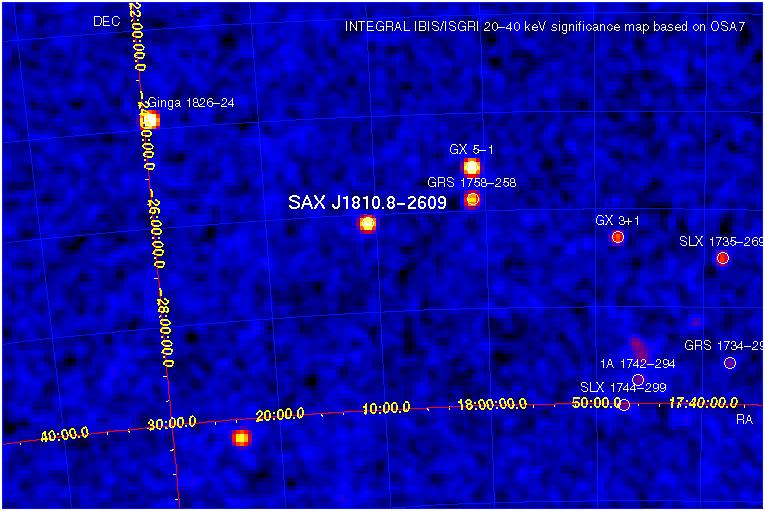
Additional material for ATel
1227:
SAX J1810.8-2609 displays increasing hard X-ray activity
by R. Galis, V. Beckmann (APC), J. Chenevez, S. Brandt (DNSC), G. Belanger, E. Kuulkers,
M. Cadolle Bel, C. Sanchez-Fernandez (ESA/ESAC), A. Bazzano,
I. Donnarumma, M. Fiocchi, L. Natalucci (INAF/IASF-Roma), D. Götz
(CEA/Saclay), W. Hermsen (SRON), J.-C. Leyder
(IAG Liege), S. Piraino (IAAT),
K. Pottschmidt (UMBC/GSFC),
N. Shaposhnikov (NASA/GSFC), A. Paizis, L. Sidoli
(INAF/IASF-Milano), J. Tomsick
(UC Berkeley),
R. Walter (ISDC), and K. Watanabe (FGCU).
Subjects: X-ray, Gamma Ray, Request for Observations, Binaries, Neutron Stars, Transients
The neutron-star LMXB SAX J1810.8-2609 has been frequently observed by
INTEGRAL over the last weeks. After the onset of hard X-ray activity
as seen by Swift on Aug. 6-9 (ATel#1175), and by INTEGRAL on Aug. 19
(ATel#1185),
the source was covered by the Galactic
Bulge Monitoring Programme (Kuulkers et al. 2007, A&A 466, 595) and in the INTEGRAL Key
Programme of the Galactic Center. The light curve of the last 2 weeks
shows a gradual brightening, which peaked on 2007-09-21T06:01 UTC with a source flux of
about 83 mCrab and 60 mCrab in the 20-40 keV and 40-80 keV band,
respectively. In addition, the JEM-X1 lightcurve shows a
type I X-ray burst lasting
about 40s on 2007-09-24T19:53:06 with a peak flux of 1.3 ±
0.2 Crab and 1.1 ± 0.3 Crab in the 3-10 keV and 10-20 keV band,
respectively (see Figure 3 below).
Analysis of IBIS/ISGRI data using INTEGRAL's latest Offline Standard Analysis
package OSA 7, shows that the spectrum above 18 keV is best represented
by a Comptonization model following Titarchuk 1994 (compTT), rather
than by a single power law, except for the short observation on
September 21, where a single power law is sufficient. As the compTT model is not
well constrained in some cases, we fix the electron seed temperature
to T0 = 1 keV in all cases and fit the plasma temperature (kT) which we
report below. In addition, we apply a single power law
model with photon index Γ in order to give a hint for the spectral slope evolution.
The spectral evolution over the last weeks appears as follows (flux in 10-10 erg cm-2 s-1):
| revolution | UT start | exp. time [ks] | flux (20-40 keV) | kT [keV] | Γ |
|---|---|---|---|---|---|
| 600 | 2007-09-12T01:25 | 185 | 2.2 ± 0.3 | 31 ± 9 | 2.11 ± 0.04 |
| 601 | 2007-09-15T01:09 | 173 | 3.5 ± 0.4 | 26 ± 4 | 2.17 ± 0.03 |
| 602 | 2007-09-18T05:01 | 11 | 3.4 ± 0.9 | 14 ± 3 | 2.1 ± 0.1 |
| 603 | 2007-09-21T04:10 | 12 | 6.0 ± 0.5 | 50* | 2.3 ± 0.1 |
| 604 | 2007-09-24T00:34 | 203 | 3.6 ± 0.3 | 49 ± 34 | 2.44 ± 0.03 |
This is the longest lasting and brightest outburst of this source observed so far by INTEGRAL. INTEGRAL continues to observe the Galactic Centre region since September 30, 2007.
Figure 1: INTEGRAL IBIS/ISGRI 20-40 keV significance map of the area
around SAX J1810.8-2609, 2007-09-15T11:37 - 2007-09-17T13:31 (revolution 601). SAX J1810.8-2609 is covered during 170 ks of ISGRI
observation time. The significance of the detection in the 15-80 keV
band is 79
sigma, with a flux of about 42 mCrab.
Figure 2: Spectral plot, using INTEGRAL IBIS/ISGRI
data of SAX J1810.8-2609 in revolution 604.
Figure 3: Lightcurve of the type I X-ray burst observed by
INTEGRAL/JEM-X1. The time of the peak corresponds to
2007-09-24T19:53:06 when SAX J1810.8-2609 reached a flux of 1.3 ±
0.2 Crab
(3-10 keV; shown in black) and 1.1 ± 0.3 Crab (10-20 keV; shown in red).
Last update: October 5th, 2007
In case of questions and comments: contact me at the APC.